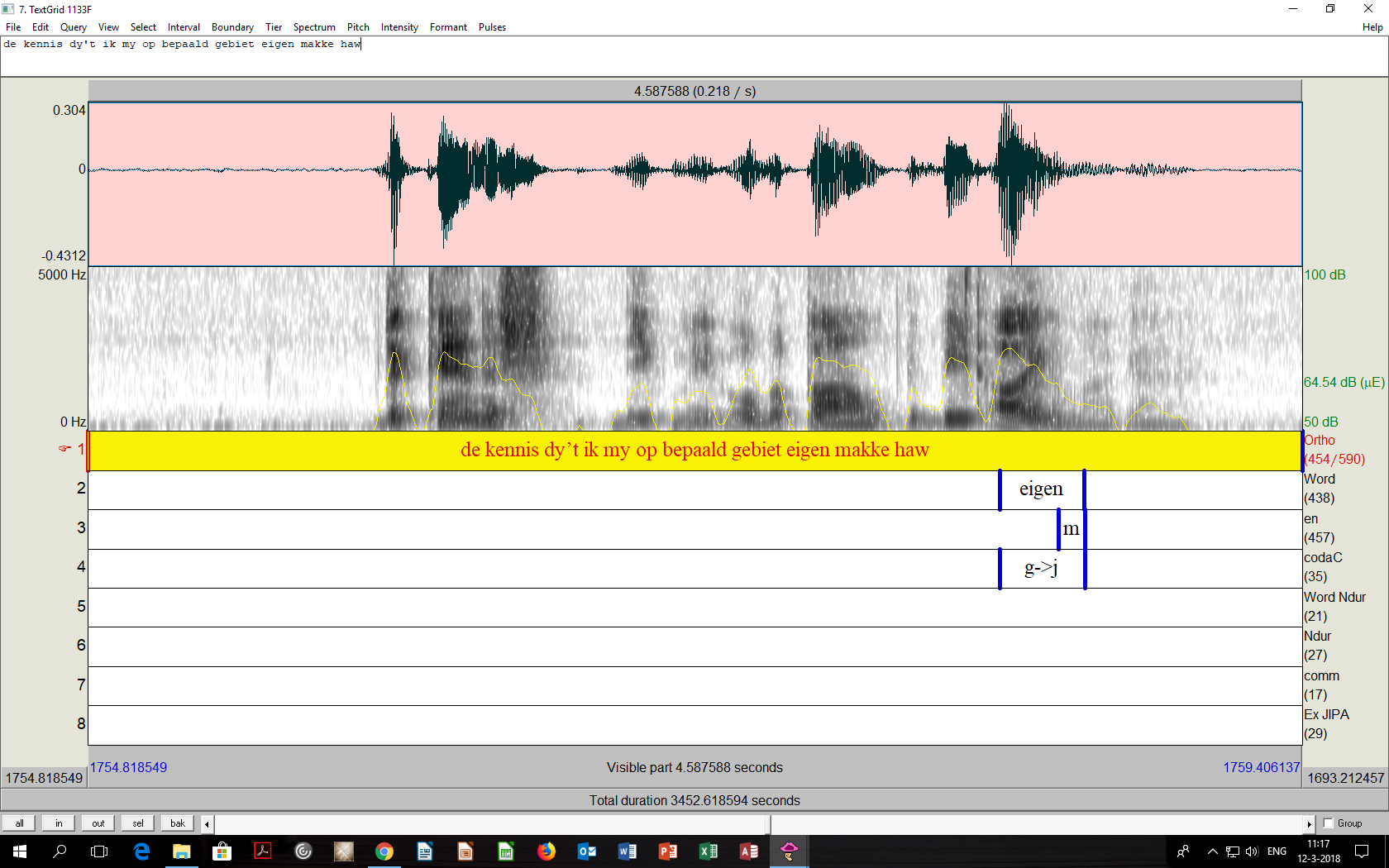Het Boarnsterhim Corpus
Synchronie en diachronie yn taal
Het Boarnsterhim Corpus (BHC) is een corpus voor onderzoekers en studenten die de fonetiek, fonologie, variatie en verandering in het gesproken Fries willen bestuderen. Het BHC zal in een grotere database van Friese corpora worden ingebed om het mogleijk te maken om de effecten van lexicale frequentie te bestuderen. De eerste gegeven worden in 2018 gepubliceerd en het corpus wordt in de komende jaren uitgebreid.
Onderzoeksthema
Synchronie en diachronie in taal
Projectleider
dr. Marjoleine Sloos
Medewerkers
ir. Eduard Drenth, dr. Wilbert Heeringa
Looptijd
01/01/2016-31/12/2019
Gefinancierd door
NWO Vernieuwingsimpuls Veni, Stichting Taalwetenschap, Friesland Bank, Fryske Akademy
Orthografische transcripties
Fries: Eke Born, Truus Bremer, Edo Eisma, Kobe Flapper, Renske Hooijenga, Hilde de Jong BA, Dik Nauta, Wytse Willem Pel, Janneke Spoelstra MA, Wilma Stienstra, Tineke Tamminga, Helga Zandberg
Nederlands: Grietje Keizer-Heeringa, Theresia Schreiber, Edmee Valk-Boon BA, Rick Weggen
Fonetische transcripties
Andrea Garcia Ariza MA, Tessa Hummel BA, Mirte Koppenberg, Bahar Soohani PhD
Interviews
Grietje Keizer-Heeringa, Dik Nauta, Theresia Schreiber

Does Frisian change towards Dutch? That question has often been asked and some evidence seems to support that idea. This question is not new. To study whether the sound system of Frisian was really changing towards Dutch, The Boarnsterhim Corpus (henceforth BHC) was recorded in 1982–1984. The studies that followed from this suggest that the Frisian sound system was largely stable. In some respects, the distinction between Frisian and Dutch became even stronger. To further investigate whether this trend continues, the BHC2 is being recorded between 2017–2019. Recordings and analyses of four generations of speech will provide a unique the opportunity to investigate the stability, variation, and change of the Frisian sound system over 100 years.
In both periods, speakers of three generations of the same families were/are recorded: grandmother, mother, and daughter; or grandfather, father, and son. The two younger generations of the first period overlap with the oldest two generations of the second period. A special feature of this corpus is that 23 speakers were recorded in both periods; which enables a longitudinal study in language change and the comparison between panel and trend studies (or real time and apparent time studies).

All speakers were/are recorded twice. One time they were recorded in Frisian with a native interviewer to ensure informal Frisian speech and the other time they were recorded in Dutch. Each recording consists of 20 read sentences, a read story (2-3 minutes), and an interview of about 40 minutes about the speaker’s use of Frisian, language attitude, and daily life activities. In the BHC1, data were recorded on cassette tapes which were digitalized in 2016.
With the help of research assistants, interns, and volunteers, the data are annotated in Praat speech processing software. This separates the phrases, words, and sounds (with an accuracy of milliseconds). There are separate tiers (levels) for:
- orthography
- words
- phonemes
- phonetic realization
- deletion of speech sounds
- specific phonological processes

Purposes
This corpus is highly suitable for research in the following fields:
- bilingualism and code-switching
- long term language change
- especially in bilingualism
- and minority languages
- the phonetics and phonology of Frisian
- real-time vs. apparent time studies into language change
- studies into the development of reading competences of Frisian
- frequency effects in language
- language and ageing
- language attitude over time
- historiographic research
- anthropological research
Publications
Sloos, Marjoleine, Eduard Drenth & Wilbert Heeringa (in press). The Boarnsterhim Corpus: A Bilingual Frisian-Dutch Panel and Trend Study. In Proceedings of the 11th edition of the Language Resources and Evaluation Conference, 7-12 May 2018, Miyazaki (Japan).
Feitsma, Antonia. 1989. Changes in the pronunciation of Frisian under the influence of Netherlandic. In Deprez, K. (ed.), Language and Intergroup Relations in Flanders and in the Netherlands, 181-193. Dordrecht: Foris.
Meekma, Irénke. 1989. Frouljuspraat en it lytse ferskil. Oer útspraakferoaring yn 'e sandhi by froulju en manlju. It Beaken 51, 115-29.
Feitsma, Tony, Els van der Geest, Frits J. van der Kuip & Irénke Meekma. 1987. Variations and development in Frisian sandhi phenomena. International Journal of the Sociology of Language 64, 81-94.
van der Kuip, Frits J. 1986. Syllabisearring yn it Frysk en it Hollânsk fan Fryskpraters. Tydskrift foar Fryske Taalkunde 2, 69-92.
